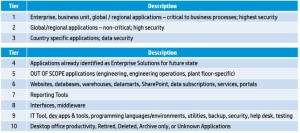First comment – don’t. The functional areas you ignore will negate any transformation in the area(s) you chose. ALWAYS perform transformation at the enterprise level if at all possible.
Second comment – make it possible (to perform a transformation at the enterprise level). ALL your arguments will be valid. Although all excuses sound sensible at first, they are dangerous rationalizations. Don’t listen…
That said, it is (somewhat) common to implement a sequential functional ‘sleeve’ approach. Once you complete all functional ‘sleeves’, you’ll have completed the entire enterprise portfolio. This is doable. However, the extended time required increases the risk of completely the entire enterprise sleeve-by-sleeve. Remember the old adage, “time kills deals” — rings true for transformation projects as well.
Pros of a Sequential Functional ‘Sleeve’ Approach
- Built-in go / no go decisions points at end of each sleeve’s assessment
- Functional-specific recommendations delivered quicker
- Allows focus on known ‘problem areas’
- Look first at high value, low risk, quick return items
- Savings from initial sleeve(s) recommendations, when implemented, could be used to fund assessment of later sleeves
- Can factor in risk / complexity to ensure success and high return early to best position higher risk, more complex efforts
Cons of a Sequential Functional ‘Sleeve’ Approach
- Takes longer, total cost is greater to asses entire portfolio using a sleeve-by-sleeve approach
- Multiple modernization roadmaps and business benefit models will need to be ‘rationalized’ into one, at the completion of the final sleeve (e.g. completed enterprise)
- All redundant functionality may not be discovered within a narrow scope of individual sleeves
- Possible re-work on earlier recommendations as additional sleeve assessments are competed
- Implementation of recommendations while completing additional sleeve assessments could add complexity to the level of effort required
- A narrow sleeve assessment would result in increased assumptions / less actual recommendations
- Retirement / replacement recommendations will need to be vetted with additional (out of scope) users of each application
Pros of Enterprise-wide Approach
- Maximized value by delivering enterprise-wide recommendations
- Recommendations will minimize conflicts for limited FTEs and funding
- Minimized time and investment in actual assessment
- Timing considerations, critical dependencies, and design complexities can be determined across the enterprise for all recommendations
- Composite view of data warehouse, business intelligence, data sources, etc. provides increased clarity
- Enterprise-wide business case makes funding decisions more strategic
- Increased business scalability and agility
Cons of Enterprise-wide Approach
- Very few recommendations are implemented until after the completion of the assessment. There are exceptions to this…
- The complete solution will be delivered in a multi-step fashion
- The enterprise-wide roadmap solution would require increased time to reach a decision / funding approval; and volatility of work and demand for client resources
- Organizational risks could be increased as multiple recommendations are implemented across broad functional areas
- Business resource availability
- End user change impact
- Other project commitments
What Both Approaches Have in Common
- Determine what applications are in use supporting the business
- Which applications score best and worst for function and technical quality
- What applications are based on ‘at risk’ technology
- What applications cost the most to maintain?
- Determine what applications should be retired, consolidated or extended
- (Assuming implementation of the findings) Reduce portfolio total cost of ownership (TCO) and / or enable spend redirection from sustaining work to high value-add initiatives
- Alignment between applications and business objectives
- Increase the performance, efficiency, and usability of a portfolio
- Similar assets will be delivered
In addition, an enterprise-wide approach can result in additional value such as analysis of:
- IT organization model
- Current projects
- Portfolio management
- Governance practices
A functional-sleeve approach will not allow an across-the-organization view of these areas. It is extremely difficult (e.g. near impossible) to stitch together a message sleeve-by-sleeve across these important areas.
Quiet convictions (e.g. enterprise view) often earn long-term respect.
See you in the future…
Frank Wood
Executive Transformation Advisor
